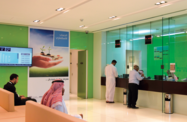The Kingdom’s insurance industry looks set to enjoy solid growth over the coming few years thanks to an increased flow of state investments and rising demand for health and property coverage. Greater awareness among Saudis of the benefits of both life and non-life insurance policies should also boost policy take-up.
It is estimated that the insurance sector’s overall contribution to GDP is currently around 1%, double the level recorded in 2006. The latest data from the Saudi Arabian Monetary Agency (SAMA), which regulates the industry, put the value of the premiums held by the insurance sector at more than $4.4bn in 2010, a 12.4% increase on the preceding year. The per-capita premium average is $160, one of the lowest in the region, though this does appear to be changing.
According to a report released in mid-March by financial analysis and ratings firm AM Best Company, there are a number of factors that have contributed to the recent growth, including an improved regulatory environment and the requirement that insurers had to be majority Saudi-owned and located onshore. While penetration rates have traditionally been low, this is changing rapidly, driven in part by increasing demand.
“The introduction of compulsory health schemes, which began with expatriates [in] 2006, has been a major driver of growth in recent years,” the report said.
This segment is likely to be given a further boost in the coming years as the government has launched an accelerated infrastructure development programme, with billions of dollars being injected into transport, energy and communications projects. Additionally, the massive public housing, industrial and education schemes that are also planned will require an increase in the number of foreign workers who will in turn require coverage.
It is not just the health segment of the industry that should feel the effects of increased state and private sector investments. The anticipated surge in construction will require contractors to insure machinery and worksites, while completed private developments, such as malls, office space and housing, will all need comprehensive coverage.
However, the report did warn that the sector also faced challenges, one of which was the crowded nature of the insurance marketplace. “Moreover, persistent low rates as a result of intense competition is likely to continue to create a difficult operating environment and pose a risk to shareholders’ equity,” the report said.
Despite the increasingly lucrative Saudi insurance sector becoming more competitive, shareholders do not appear worried. So far this year, the insurance sector has been one of the best performers on the Tadawul, the Saudi stock exchange, with shares in listed policy writers up by an average of almost 30%. There have been some suggestions that the sector is showing signs of overheating, however.
According to a report by the Saudi Gazette in March 2012, the sector’s average price-earnings ratio is estimated to be around 20 times that of this year’s earnings – a ratio significantly higher than seen in other sectors – though this activity could also be an indication of the positive outlook projected by the industry.
Earlier this year, ratings agency Standard & Poor’s (S&P) was equally upbeat about the sector’s prospects, saying that local insurers should be able to maintain profitability going forward on the back of the Kingdom’s continued overall socio-economic development and the accompanying demand for more protection and savings solutions.
Like AM Best Company, S&P did note that the there was a high degree of competition in the sector, with more than 30 firms in the marketplace. As a result, margins for operators were currently tight, though the rivalry can bring with it a benefit for customers, as companies seek to attract business by keeping policy rates low.
According to S&P, the pressure caused by overcrowding in the market should be eased somewhat by the increased take-up of coverage as the economy grows, expanding in both size and sophistication.
“With more profitable business available, market participants will be able to expand organically without taking market share from their competitors,” S&P said in its survey. “While insurance penetration remains low as a percentage of GDP, it is growing fast and it is expected that as the economy grows, so will the insurance sector.”
While the relatively low rate of penetration does present something of a challenge for Saudi insurance firms, they are working to improve the profile of their products to increase policy sales in the domestic marketplace. With the stronger flow of development projects in the economy, and an improving awareness of insurance as an investment option, underwriters should be kept busy this year and beyond.

